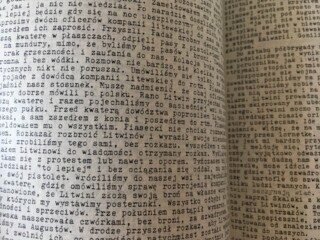Overcoming Gutenberg
Erica Eisen on Samizdat
Established by the Polish government-in-exile in 1942, London’s Polish Library has been housed at the Polish Social and Cultural Association (POSK) in Hammersmith since 1974. Its holdings include a substantial collection of samizdat: texts that were typed, mimeographed, xeroxed and occasionally photographed for clandestine distribution under communism. Andrei Sinyavsky once described samizdat as Soviet Russia’s ‘second literature’. The word is said to have been coined by Nikolai Glazkov in the early 1950s. Julius Telesin described its origins in a piece for Encounter in February 1973, without naming Glazkov. Telesin’s anonymous poet
bound together the typewritten sheets of his poems and wrote samsebyaizdat where the name of the publishing house normally appears in a book. The word was invented on the model of the names of many Soviet publishing houses: politizdat (publishing house for political literature), voyenizdat (military literature), yurizdat (legal literature), and so forth. Well, samsebyaizdat means ‘publishing house for oneself’.
The word may have been new, but the practice wasn’t. Telesin quoted Marina Tsvetaeva: ‘I copy out poems sewn together in notebooks and sell them. We call this “overcoming Gutenberg”.’
Given the straitened material circumstances under which samizdat copyists worked, it’s unsurprising the books look so different from their mass-produced equivalents. The POSK library has a copy of Józef Mackiewicz’s The Road to Nowhere, the margins of which are so tight that the ends of each line disappear into the gutter. In Józef Szostak’s My Service for Independent Poland the individual words are technically legible, but every page is a forbidding wall of minuscule type.
Some samizdat editions were typed ten or more at a time on onion-skin paper; the text can be so faint as to be nearly incomprehensible. In a collection of Feuilletons by Eva Kantůrková, now in the British Library, the lines are so pale and fuzzy that examining it is like reading through a dense fog. The paper is thin enough that ghostly traces of the next page’s sentences are visible as you read, like omens of the future. The British Library has one of the world’s most extensive collections of Czechoslovak samizdat; many of the books were produced by the ‘publishing houses’ run by Ludvík Vaculík and Václav Havel.
Books made in this way bear visible traces of the mechanical obstacles the copyists faced: one copy of Ivan Klíma’s Franz and Felice was evidently hammered out on a typewriter with a faulty P key. Mistakes or difficulties with copying sometimes left books with off-kilter text or margins that were irregular or virtually non-existent. Although samizdat books were both produced and read illegally, they often include the same formal elements as official publications: tables of contents, pagination, author biographies, even the occasional silk ribbon bookmark. Typists played with Xs and Os to make page dividers and embellishments. But however normal-looking the contents of these books may be, their plain covers – often either cardboard or a dull-coloured linen – have a telling blank where the title and author should be.
The handmade bindings, crooked lines, pencilled-in addenda and ghostly letters are a concrete testament to the effort and devotion of the books’ anonymous makers. In a signed copy of Havel’s Redevelopment, the punctuation and diacritics have all been painstakingly gone over in pen. I imagine the book’s maker sitting bent over their desk, carefully redoing each full stop, comma, accent and háček one by one, for the benefit of future readers they would never meet.
